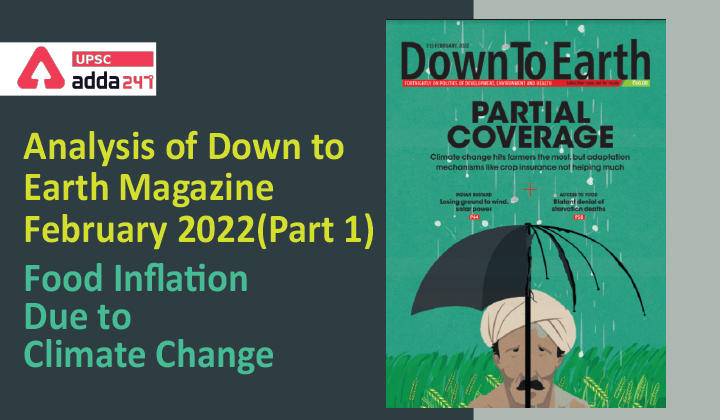Table of Contents
Food Inflation Due to Climate Change
Relevance
”GS 3: Growth & Development, Monetary Policy, Climate Change”
Introduction
- At 14. 23 per cent, India’s wholesale inflation rate in November 2021 was the highest in three decades.
- December 2021 is the ninth consecutive month to see WPI rise in double digits.
- The high December inflation rate was unexpected because the government had reduced taxes on fuels—a major add-on to overall inflation.
- The current situation is being compared to the rise in food prices in 2011, which had led to riots across Asia, especially West Asia and Africa, leading to anti-government protests, popularly known as the Arab Spring, and regime changes.
What is WPI?
- Wholesale Price Index, or WPI, measures the changes in the prices of goods sold and traded in bulk by wholesale businesses to other businesses.
- WPI is unlike the Consumer Price Index (CPI), which tracks the prices of goods and services purchased by consumers.
- Primary articles is a major component of WPI, further subdivided into Food Articles and Non-Food Articles.
- The monthly WPI number shows the average price changes of goods usually expressed in ratios or percentages.
- The WPI tracks prices at the factory gate before the retail level.
- Wholesale price index (WPI) inflation is always a cause of concern since it can lead to higher retail inflation.
Why is inflation so high?
- As it emerges, food inflation, particularly the rise in prices of vegetables and a few foodgrains, has been a driver of present episodes of overall inflation.
- India’s wholesale price inflation peaked in November 2021 due to a surge in primary food inflation that hit a 13-month high. In many states, prices of seasonal vegetables are seeing an unprecedented rise.
- The answer to the current surge is crop loss due to extreme weather events, and the trend is not limited to India.
- Food inflation is rising across the world.
What does the worldwide trend show?
- On January 7, the Food and Agricultural Organization’s (fao’s) Food Price Index showed that food prices had reached a decade high, with an average rise of 28 per cent over the previous year.
- Adjusting for inflation, the average food prices in the 11 months of 2021 are the highest in 46 years, says fao.
How does data relate to weather anomalies and rising inflation?
- Between 1956 and 2010, there were nine double-digit inflation episodes. Of these, seven were caused by drought conditions, as per the Reserve Bank of India (rbi).
- In the past six decades, there have been three major episodes of significantly high food prices globally: 1970s, 2007-08 and 2010-14. All these were triggered by weather shocks followed by factors such as an increase in oil prices, trade policy interventions and biofuel consumption.
- The current episode seems to be entirely driven by weather anomalies.
Future Expectations
While normally high prices are expected to give way to increased production, the high cost of inputs, ongoing global pandemic and ever more uncertain climatic conditions leave little room for optimism about a return to more stable market conditions even in 2022.
Earlier Examples
- A similar situation caused the last high price episode in 2019-2020. Rising prices of food items, particularly of vegetables, caused retail inflation to rise to a 68-month high of 7.59 per cent in January 2020.
- Extreme weather events had damaged crops, leading to a collapse of the supply of vegetables at a time of the year when they usually flood the markets.
- On the basis of year-on-year comparison, vegetable prices had gone up by 50.19 per cent since January 2019. They increased by 45.56 per cent in rural areas and markets during this period and by 59.31 per cent in urban areas. Of the six categories of consumption items used in tabulating the overall inflation figure, food and beverages recorded the highest price rise, thus increasing the overall inflation rate.
- In 2014, rbi pointed out: “One of the traditional explanations for rising food prices has been the supply-side shocks related to weather either because of droughts or floods.”
Impact of Climate Change Worldwide
- The current global food inflation is driven predominantly by wheat, which reported price rise due to drought and high temperature in major producing countries.
- In 2021, as various trade reports show, spring wheat production declined by 40 per cent in the U.S. Russia, the world’s largest exporter of wheat, also harvested less and has now imposed a tax on wheat export to ensure ample stock for domestic consumption.
- Unusual frosts in Brazil’s coffee bean producing areas in July 2021 have led to a production dip of up to 10 per cent. According to the forecast of the International Coffee Organization, the climatic onslaught on the world’s top coffee producer would lead to price rise for the next two years.
Conclusion
The fact is by changing the rain and its distribution, climate change is altering the very axis of agriculture.



 TSPSC Group 1 Question Paper 2024, Downl...
TSPSC Group 1 Question Paper 2024, Downl...
 TSPSC Group 1 Answer key 2024 Out, Downl...
TSPSC Group 1 Answer key 2024 Out, Downl...
 UPSC Prelims 2024 Question Paper, Downlo...
UPSC Prelims 2024 Question Paper, Downlo...
